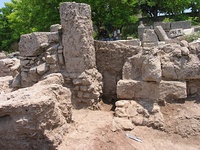| Collection: | Corinth | |
| Type: | Basket | |
| Name: | Nezi Field, context 6521 | |
| Area: | Nezi Field | |
| Context Type: | Fill | |
| Title: | robbing trench fill? | |
| Category: | Deposit | |
| Notebook: | 1103 | |
| Context: | 6521 | |
| Page: | 0 | |
| Date: | 2009/05/29 | |
| Stratum: | 20%: tile, bone, angular ceramics | |
| Description: | The soil color is dark pinkish brown. The soil compaction is weakly cemented. The soil is poorly sorted. It is sandy silt. | |
| Notes: | 6517 revealed this context- a uniform stripe of mixed fill, filling a clear cut into the stratum revealed by 6498. The working hypothesis is that this represents an east-west robibng trench fill for fugitive wall 6522. This wall would have bounded the room to the north; it was later robbed and/or truncated in order to accommodate a number of bothroi. Initially, it was thought that the threshold that gives east-west communication between this area and the room to the west of it (6285) would have been well out of use before this wall existed and was robbed, since the floor surface that is currently exposed there (as yet unnumbered) seemed to have an association with 10th century levels, and this robbing trench is more likely a TAQ of 11th century (it will be important to get the dates for the surface it cuts, and for the fill). When we reached the bottom of the fill level, revealing the shape of the cut, we noticed that the level where it stopped was mostly above the rubble foundations of east-west wall 6522. Therefore, it seems likely that this cut was excavated in order to rob the larger stones that formed the courses of wall 6522, rather than for construction purposes (e.g., for containing the FOUNDATIONS of wall 6522). Therefore, the surface it cuts (as yet unnumbered) will be a TPQ for when the wall was out of use, and robbed and filled. And the context that revealed the lines of the cut (6498) would give a TAQ for when the wall's use ended. When Panos reached the eastern boundary and cleaned the stones in the foundation there, he realized that the boulders forming the foundation went BENEATH the east-west wall. This was surprising and demonstrated an important point: the large stones forming the eastern boundary of the area were laid IN CONJUNCTION with with east-west stretch 6522. The stones of the foundation are large and would have formed a base for a very substantial stretch of wall. Our working hypothesis for this stretch, in light of the fact that it cuts into putative virgin red soil, is that it represented the original terrace/support wall for this space. And in light of the POSITION of the wall, it must predate the construction of the threshold 6285 and wall sections 6027 and 6300- especially if foundation trench cut 6509 truncates robbing event 6523, as it appears to do. Logically, the order makes sense with this change sequence; the easternmost rom would have been an eastern north-south running wall with the northern boundary defined by east-west wall 6522. It would have retained red earth. Then, the robbing event designated as 6523 would have ripped out the northern boundary of the room, also truncating the foundation trench for the east-west wall 6522. The room would have been open for use. At this point, the western boundary for the room would have changed with the construction of wall section 6285-6300=6027, and the space would have been traversible through that door. This also explains why the earliest floor that appears together with 6285 appears to be comprised of red soil. We'll continue with the same martyr by wall 6027 to see if we find more foundation fill. | |
| Context Pottery: | Fineware. preroman11 bodysherds. ; Coarseware. pitcher. 1 bodysherd. ; Cooking ware. stewpot. 1 bodysherd. ; Coarseware. pedestalled dish. 1 rim. | |
| Pottery Summary: | 12 frag(s) 0.04 kg. (0% saved) fineware. | |
| 120 frag(s) 1.42 kg. (0% saved) coarseware. | ||
| 32 frag(s) 0.14 kg. (0% saved) cooking ware. | ||
| Context Artifacts: | Bone- Not in Table - 1 example(s).; Bone- cranial of Capra aegagrus hircus (Sheep/Goat) - 1 example(s).; Bone- femur of Capra aegagrus hircus (Sheep/Goat) - 1 fragment(s). ; Bone- hyoid of Capra aegagrus hircus (Sheep/Goat) - 1 example(s).; Bone- innominate of Capra aegagrus hircus (Sheep/Goat) - 1 example(s).; Bone- limb bone, undiff. of Mammalia, lg (Mammal - Large) - 1 example(s).; Bone- scapula of Capra aegagrus hircus (Sheep/Goat) - 1 example(s).; Bone- tarsal, astragalus of B. taurus (Cattle) - 1 example(s).; Bone- tibia of Capra aegagrus hircus (Sheep/Goat) - 1 fragment(s). ; Bone- tooth of Sus scrofa (Wild Boar or Domestic Pig) - 1 example(s).; Bone- vertebrae of B. taurus (Cattle) - 1 example(s).; Bone- vertebrae, thoracic of Capra aegagrus hircus (Sheep/Goat) - 1 example(s). | |
| Period: | Byzantine | |
| Chronology: | 10th/11th, npd | |
| Grid: | 281.55-279.29E, 1021.06-1026.46N | |
| XMin: | 279.29 | |
| XMax: | 281.55 | |
| YMin: | 1021.06 | |
| YMax: | 1026.46 | |
| Site: | Corinth | |
| City: | Ancient Corinth | |
| Country: | Greece | |
| Masl: | 84.31-84.63m. | |
| References: | Image: digital 2009 2167 Image: digital 2009 2168 Image: digital 2009 2169 |
|


